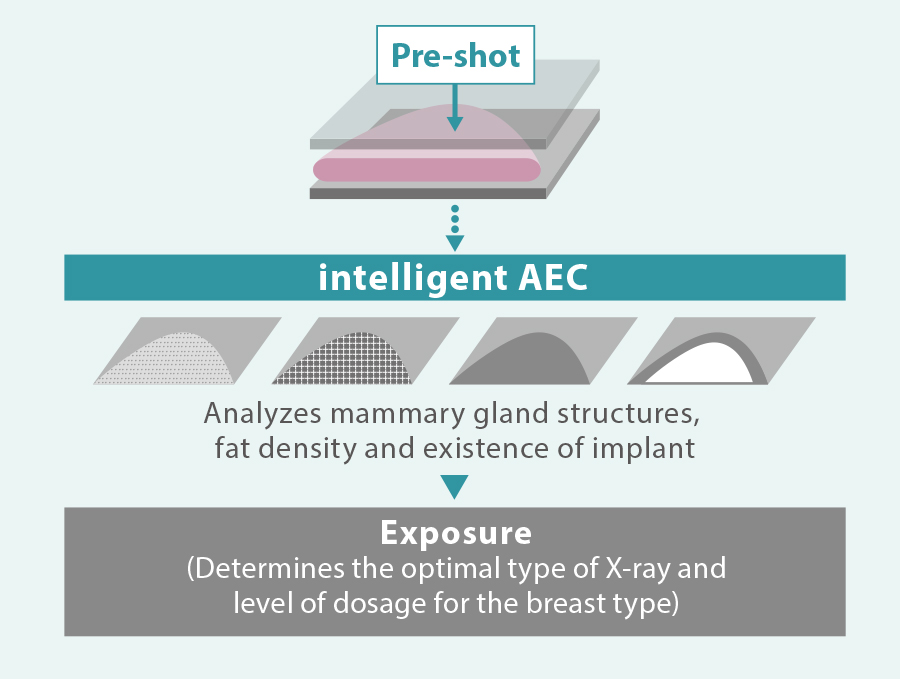This webpage content is intended for Healthcare Professionals only, not for general public.
Solution to support diagnosis

Unique detector for fast, low dose examinations
AMULET Innovality employs a direct-conversion flat panel detector made of Amorphous Selenium (a-Se) which exhibits excellent conversion efficiency in the mammographic X-ray spectrum. The HCP (Hexagonal Close Pattern) detector efficiently collects electrical signals converted from X-rays to realize both high resolution and low noise. This unique design makes it possible to realize a higher DQE (Detective Quantum Efficiency) than with the square pixel array of conventional TFT panels. With the information collected by the HCP detector, AMULET Innovality creates high definition images with a pixel size of 50 μm; the finest available with a direct-conversion detector.
This low-noise and high-speed switching technology allows tomosynthesis exposures with a low X-ray dosage and short acquisition time to be performed. Fast image display is also possible, realizing a smooth mammography workflow from exposure to image display.

Conventional square pixel

AMULET Innovality hexagonal pixel
ISC – Adjusted contrast and low X-ray dose using a Tungsten Target
Image-based Spectrum Conversion*1 (ISC) technology can be used to adjust contrast in an image. ISC analyzes images to compensate for variations in contrast due to the density of mammary glands, amount of fat and X-ray spectrum. ISC aims to ensure that images display adequate contrast even with the use of a high energy, low-dose X-ray beam. This technology allows sites that previously exploited the superior contrast of a Molybdenum target to realize the dose advantages offered by the use of Tungsten without having to compromise image contrast.
- *1 Based on Image analysis the appearance is adjusted to emulate the image quality with the simulated “optimal” spectrum.
DYN II – Provides high contrast image without saturation in breast region
Dynamic Visualization II (DYN II) provides consistent appropriate density of glandular and adipose tissue in each breast type, so the contrast of thick breast and dense breast is improved. Furthermore, it provides high contrast with no saturation in breast region, so the sites are possible to set high contrast parameter.

DYN II

MFP
Dedicated mammography AWS (Acquisition Workstation)

AWS

High definition second monitor

Optimal examination workflow
- Integrated X-ray controller allows setting and confirmation of exposure conditions on a single screen.
- Examination screen can be split and switched between 1, 2, or 4 image display.
- Individual images can be immediately output to a PACS, viewer or printer during an examination.
- Density and contrast can be easily adjusted while viewing images.
- Alignment of left and right images can be adjusted both automatically and manually.
High definition second monitor (3M/5M: Optional)
- A second, high resolution monitor can be added to the AWS making it possible to display previous images recalled from a PACS to ensure the mammographer has access to previous images at all times.
- For Tomosynthesis, reconstructed images can be displayed.

7 supported languages
Patient information display
The information shown on the display (A) at the base of B the exposure unit can be switched between patient information (ID, name, date of birth, etc.) and positioning information (angle of swivel arm, compression force and breast thickness). Positioning information can also be confirmed on the display (B) on the compression arm.
Unique detector for fast, low dose examinations

intelligent AEC has advantages in defining the appropriate dose for an examination compared to conventional AEC systems where the sensor position is fixed. Through the analysis of information obtained from low- dose preshot images, intelligent AEC makes it possible to consider the mammary gland density (breast type) when defining the x-ray energy and level of dose required. Able to be used even in the presence of implants; intelligent AEC enables more accurate calculation of exposure parameters than is possible with conventional AEC systems. By allowing the use of automatic exposure for the implanted breast, intelligent AEC can further enhance examination workflow.
intelligent AEC

Automatically selects the appropriate mammary gland area from pre-shot images
Conventional AEC

Manual sensor AEC
Requires manual adjustment of the setting based on the assured location of mammary gland

Automatic sensor AEC
Automatically selects the appropriate sensor from the pre-shot images

Breast Density Measurement
As information for doctors to classify the breast more quantitatively, calculation in the mammary gland area was added to the "mammary gland volume measurement function" that automatically calculates the mammary gland volume in the breast area from a mammography image. This mammary gland volume measurement in the breast area/mammary gland area can also be calculated with Tomosynthesis images
CEDM function
With one compression, it continuously performs low tube voltage (low energy) imaging close to the ordinary mammo- graphy imaging and high tube voltage (high energy) imaging with a Cu filter, and automatically generates and displays a subtraction image of the obtained images. This subtraction image constitutes an image emphasizing specific tissues.

- * When an iodine-based contrast agent is used
- * Some items are optional, please contact your subsidiary for the detail.
- * Fujifilm makes no representation that products on this website are commercially available in all countries.
- * Approved uses of products vary by country and region.
- * Specifications and appearance of products are subject to change without notice.











![[photo] INNOMUSE, the Women's Health Solution by Fujifilm](https://asset.fujifilm.com/www/my/files/styles/1120x200/public/2023-09/7ed50a07ef19190a2c86a5475b7d9ac6/bnr_innomuse_pc.jpg?itok=ROtP55GB)
![[photo] AMULET BellusⅡ](https://asset.fujifilm.com/www/my/files/2020-05/88a0aab95342a0a4728d0ba37fff01d2/thumb_amulet-bellus-2_01.jpg)
![[photo] Computer monitor with FUJIFILM Digital Mammography CAD software on screen](https://asset.fujifilm.com/www/my/files/2019-11/a62e2989638c8941ce0a3908f18516a7/thumb_mammography-cad_01.jpg)

